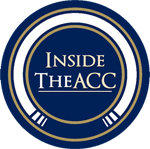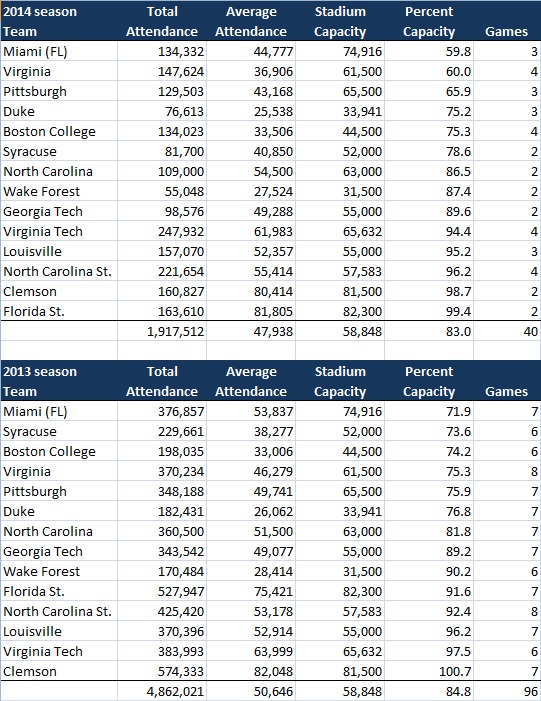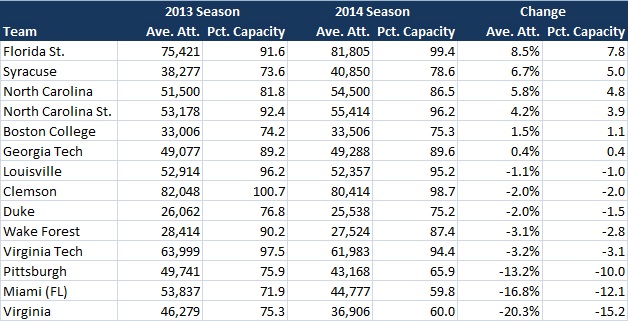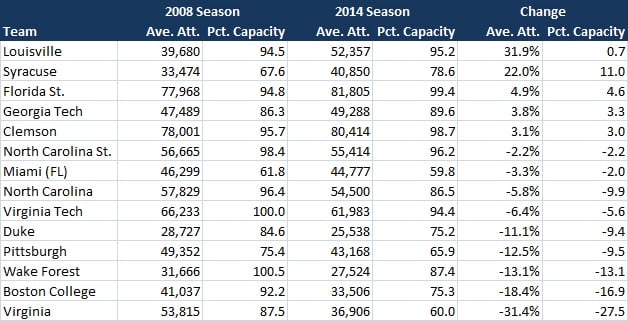It’s early in the season, and some of the best conference games are yet to come. Here’s a look at ACC football attendance so far this year.
Per attendance figures listed on stats.ncaa.org, average attendance at ACC home games for the month of September was 47,938 fans, down from 50,646 for the entire 2013 season. Average percent capacity of stadium filled declined from 84.8% in 2013 to 83.0% so far in 2014.
College football attendance has been a hot topic in the media in the last couple of years, and some excellent articles have been written in just the last few months on the topic. Factors working against attendance range from escalating ticket prices to an abundance of games on television, and a younger generation that is harder for athletic departments to entice into attending games, since the cost of entry these days (in terms of athletic department donations and ticket prices) is much higher than it was ten or twenty years ago.
But this article isn’t intended to be an examination of trends in college football attendance, just a quick look at what’s going on around the ACC so far in 2014.
Here’s a comparison of 2013 and 2014 attendance, sorted by percent capacity for each year.
A couple of notes:
- So far in 2014, three teams are below 70% capacity. None were below 70% in 2013.
- In both years, the number of teams above 80% is eight.
At this point, almost no conclusions can be drawn from the drop in attendance across the ACC. For many Power 5 schools, September is a month with three or four home games, and at least one of those home games is often against an FCS team or a lower-level FBS team — not a great draw, unless it’s the season opener. In any event, many fans can’t make every home game during September, and they pick one game and skip it.
Four ACC teams had four home games in September: Virginia, Boston College, Virginia Tech, and NC State. Virginia Tech, for example, drew just 59,625 for their game against Western Michigan, versus 62,000+ for their other three home games.
Let’s take a look at each team’s 2014 attendance vs. their 2013 attendance. The table is sorted by average attendance increase (in percent).
Most ACC teams will probably see stronger attendance for the rest of the season, as they welcome conference opponents and rivals.
Some notes:
- Miami’s schedule so far in 2014 has included FAMU, Arkansas State, and Duke. The ‘Canes welcome FSU in November, and that will boost their attendance numbers greatly.
- Virginia has hosted UCLA and Louisville, but the Cavs have still seen a big drop in their average attendance, coming off a 2-10 season last year. The Cavs are much improved, and their remaining home schedule includes UNC and Miami, but Virginia Tech won’t visit this year.
- Pittsburgh has only played Delaware, Iowa, and Akron at home so far this year. They’ll host Virginia Tech, Georgia Tech, Duke, and Syracuse later this year. The Hokies and Orange should have good attendance.
- Duke will finish with a trio of teams at home that should increase their attendance: Virginia Tech, UNC, and Wake Forest.
- Syracuse played their “home” game against Notre Dame at MetLife Stadium, and attendance was 76,802, but that’s not included in their 2014 figures. The Orange will host Louisville this Friday night and FSU the following Saturday.
- UNC’s home schedule so far has included Liberty and San Diego State. Look for the Heels to get a boost from Virginia Tech visiting this weekend and NC State visiting at the end of the season.
- Wake Forest has only hosted Gardner-Webb and Army. The Deacs should draw very well for their last two home games: Clemson and Virginia Tech.
- Virginia Tech’s 2014 numbers will probably not catch up with their 2013 numbers. The Hokies host Miami, but that’s on a Thursday night, and the post-Thanksgiving Virginia game hasn’t been the draw it used to be.
- Louisville has a very good home schedule to wrap up the year: NC State, Florida State and Kentucky should all draw well.
- NC State’s attendance increase has been commendable, given their record last year (3-9, 0-8 ACC) and the fact that last year’s home schedule included Clemson, UNC, and ECU. The Pack close with BC, GT, and Wake Forest this year.
- FSU won’t have any problems with attendance. They’re the defending national champions, and remaining home opponents include Notre Dame and Florida.
- Clemson has seen a slight dip since last year, but it’s negligible, and the Tigers still await NC State (this weekend), Louisville, and South Carolina. Clemson should close strong.
What about if you go farther back, and compare 2014 attendance to 2008 attendance? Here’s a similar table to the one above, sorted by average attendance increase (in percent).
Notes:
- Louisville added 13,000 seats to their stadium in 2010, which has led to their huge attendance increase. Their percent capacity attendance has remained roughly the same, as Cardinal fans have supported the team well for years.
- Syracuse was mired in mediocrity in 2008, coming off a 2-10 record in 2007 and posting a 3-9 record in 2008. The program is better these days (15-11 in 2012 and 2013), leading to an increase in attendance, but they’re still far short of capacity.
- UNC increased Kenan Stadium by 3,000 seats in 2011, but has still seen a drop in attendance since the 2008 heyday of the Butch Davis era, when the program was on the rise.
- Wake Forest won the ACC in 2006 and went 9-4 in 2007, leading to good attendance in 2008. Since then, the Deacs have fallen on hard times and have changed coaches, so attendance is down 13.1% versus 2008.
- Virginia has seen a dramatic drop of 31.4% since 2008, the worst by far in the league. Despite an attractive home schedule in 2014, the Cavs are suffering the effects of a cumulative 6-18 record in 2012-13.
As mentioned above, college football attendance has been a hot topic in the media lately, and some ACC schools are feeling the pinch. But more often than not, winning cures everything, and as the 2014 season goes on and conference games and rivalry games take place, ACC attendance should rise to levels comparable to last season.





